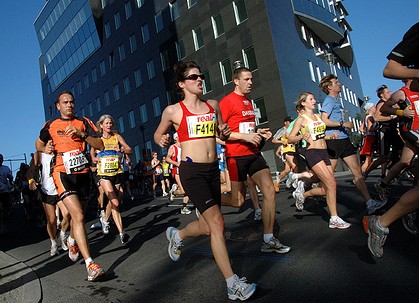True
runners consider the marathon as the ultimate endurance test. Every
runner dreams of competing in a marathon, and most of the time it’s
not for the glory of winning but for the personal challenge. However,
preparing for a marathon can be both exciting and disgusting. When
the weather is fine and you had great sleep, everything is perfect.
But not every day of training is always like that.
Running
for a marathon is a demanding, high-risk sport. You have to be
absolutely fit for this. Even highly trained and experienced runners
get injured on the track. This is why you have to be absolutely
careful and disciplined.
Have
realistic expectations.
Runners
are not made the same. Some just have better genetics than the
others. Some runners are built for competing. Others are just for
recreational marathons. The latter can always work harder to try to
get their goals. Know what you are capable of at the moment. Also,
picture yourself amid different runners you know. Don’t try to
compete with someone who has been around on the tracks for years. Try
to use them as an inspiration to get better.
Know
this is a high-risk sport.
Thousands
of runners get injured each year. Some luckily survive their injuries
and get back on training just fine. Others are not so lucky enough.
Running for a marathon is so much different than the daily jogging
you do in the neighborhood. It is so much more physically demanding.
It puts so much stress on your entire body, not just muscles and
joints. Many runners have collapsed during the competition due to
dehydration or hypothermia.
Check
your health.
People
with heart problems can’t run on a race. You best hope your heart
is in absolutely great shape before training for a marathon. Running
demands so much cardiovascular work. If your heart is not up to par
for the demands of a race, you are probably better off finding a less
strenuous sport. Needless to say, people recovering from injuries may
have to spend months in rehabilitation before getting back to
training.
Build
your endurance.
This is both fun and difficult. No famous runner ever started with
superior endurance. Everyone had to train. Everyone had to start
somewhere. You too have to start where the winners once did. Jogging
may be boring, and you are probably itching to sprint. No! Start
slow. Take it easy. Don’t be carried away by your enthusiasm. Your
muscles, tendons, bones, joints, heart, and lungs all have to adapt
slowly to a step-by-step increase in demand. So you start with
jogging. Then you move to running, and you slowly build mileage and
speed. This takes months and years. Be patient.
Run
3-5 days a week.
Once
you feel that your muscles and joints are strong enough, start
incorporating weekly runs into your training. Mileage and speed are
two important factors. Aim to increase mileage and speed by a max of
10% each week.
Join
in low-key races.
Once
you have built endurance, once you can run 10 miles without feeling
like you’re going to die at the end, then start joining local
marathons. Local marathons are great for amateurs because of the
familiarity of the track. See how you fare against other local
runners.
Continue
with your training.
Challenge
yourself. Increase mileage and speed. Join more competitions.

No comments:
Post a Comment